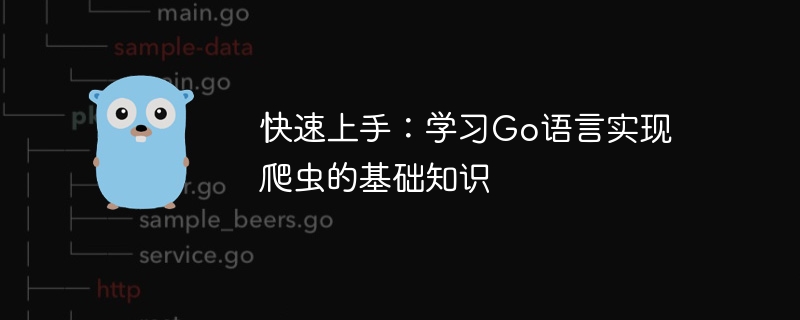Home >Backend Development >Golang >Getting Started Guide: Master the basic concepts of crawler implementation in Go language
Getting Started Guide: Master the basic concepts of crawler implementation in Go language
- WBOYWBOYWBOYWBOYWBOYWBOYWBOYWBOYWBOYWBOYWBOYWBOYWBOriginal
- 2024-01-30 08:07:05680browse

Get started quickly: Learn the basic knowledge of Go language to implement crawlers, you need specific code examples
Overview
With the rapid development of the Internet, the amount of information is huge and constantly changing. With the growth, how to obtain useful information from massive data has become a critical task. As an automated data acquisition tool, crawlers have attracted much attention and attention from developers. As a language with excellent performance, strong concurrency capabilities and easy to learn, Go language is widely used in the development of crawlers.
This article will introduce the basic knowledge of crawler implementation in Go language, including URL parsing, HTTP request, HTML parsing, concurrent processing, etc., combined with specific code examples to help readers get started quickly.
- URL Analysis
URL (Uniform Resource Locator) is the address of an Internet resource, and a specific web page can be located through the URL. In Go language, we can use the net/url package to parse and process URLs.
The following is a simple example:
package main
import (
"fmt"
"net/url"
)
func main() {
u, err := url.Parse("https://www.example.com/path?query=1#fragment")
if err != nil {
fmt.Println("parse error:", err)
return
}
fmt.Println("Scheme:", u.Scheme) // 输出:https
fmt.Println("Host:", u.Host) // 输出:www.example.com
fmt.Println("Path:", u.Path) // 输出:/path
fmt.Println("RawQuery:", u.RawQuery) // 输出:query=1
fmt.Println("Fragment:", u.Fragment) // 输出:fragment
}By calling the url.Parse function, we parse the URL into a url.URL structure and can access its various components , such as Scheme (protocol), Host (host name), Path (path), RawQuery (query parameters) and Fragment (fragment).
- HTTP request
In the crawler, we need to send an HTTP request based on the URL and obtain the data returned by the server. In the Go language, you can use the http package to send HTTP requests and process server responses.
The following is an example:
package main
import (
"fmt"
"io/ioutil"
"net/http"
)
func main() {
resp, err := http.Get("https://www.example.com")
if err != nil {
fmt.Println("request error:", err)
return
}
defer resp.Body.Close()
body, err := ioutil.ReadAll(resp.Body)
if err != nil {
fmt.Println("read error:", err)
return
}
fmt.Println(string(body))
}By calling the http.Get function, we can send a GET request and obtain the data returned by the server. The entity content of the response can be obtained through resp.Body, read out using the ioutil.ReadAll function and converted into a string for output.
- HTML parsing
In crawlers, we usually extract the required data from HTML pages. In Go language, you can use goquery package to parse HTML and extract data.
The following is an example:
package main
import (
"fmt"
"log"
"net/http"
"github.com/PuerkitoBio/goquery"
)
func main() {
resp, err := http.Get("https://www.example.com")
if err != nil {
log.Fatal(err)
}
defer resp.Body.Close()
doc, err := goquery.NewDocumentFromReader(resp.Body)
if err != nil {
log.Fatal(err)
}
doc.Find("h1").Each(func(i int, s *goquery.Selection) {
fmt.Println(s.Text())
})
}By calling the goquery.NewDocumentFromReader function, we can parse the entity content of the HTTP response into a goquery.Document object, and then use this object's The Find method finds a specific HTML element and processes it, such as outputting text content.
- Concurrency processing
In actual crawlers, we often need to process multiple URLs at the same time to improve crawling efficiency, which requires the use of concurrent processing. In Go language, you can use goroutine and channel to achieve concurrency.
Here is an example:
package main
import (
"fmt"
"log"
"net/http"
"sync"
"github.com/PuerkitoBio/goquery"
)
func main() {
urls := []string{"https://www.example.com", "https://www.example.org", "https://www.example.net"}
var wg sync.WaitGroup
for _, url := range urls {
wg.Add(1)
go func(url string) {
defer wg.Done()
resp, err := http.Get(url)
if err != nil {
log.Fatal(err)
}
defer resp.Body.Close()
doc, err := goquery.NewDocumentFromReader(resp.Body)
if err != nil {
log.Fatal(err)
}
doc.Find("h1").Each(func(i int, s *goquery.Selection) {
fmt.Println(url, s.Text())
})
}(url)
}
wg.Wait()
}By using sync.WaitGroup and goroutine, we can process multiple URLs concurrently and wait for their execution to complete. In each goroutine, we send HTTP requests and parse HTML, finally outputting text content.
Conclusion
This article introduces the basic knowledge of crawler implementation in Go language, including URL parsing, HTTP request, HTML parsing and concurrent processing, etc., and explains it with specific code examples. I hope that after reading this article, readers can quickly get started using Go language to develop efficient crawler programs.
The above is the detailed content of Getting Started Guide: Master the basic concepts of crawler implementation in Go language. For more information, please follow other related articles on the PHP Chinese website!
Related articles
See more- How to display and hide HTML elements through display or visibility
- What does python crawler do?
- What is the difference between go language and java? A simple comparison between go language and java
- Python crawler task order receiving channel
- Get started quickly: Tutorial on developing and implementing PHP WebSocket functions

